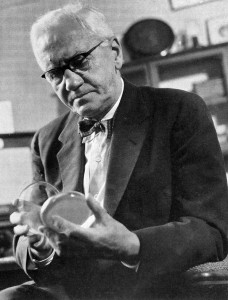
When we think of the discovery of antibiotics, we commonly think of Sir Alexander Fleming’s discovery of penicillin in 1928. The first time it was used for medical treatment was years later in the 1940s, after which it changed the face of modern medicine. The period between then 1940s and 1960s is often referred to as the golden age of antibiotics, when new classes of antibiotics were discovered every few years. Before revisiting this commonly retold history of antibiotics, it is worth exploring older historical evidence of antibiotic usage that predates Fleming’s discovery.

In the 1980s, an archeological study of Sudanese Nubians found evidence of tetracycline in the bones (Bassett et al. 1980). Tetracycline is a broad-spectrum antibiotic used for urinary, respiratory and intestinal infections. These bones were roughly 1500 years old, from an agricultural society that lived on the plains of the Nile. Wheat and barley were staple grains for the Nubians, and the tetracycline residues were probably derived from stored grains that contained antibiotic-producing Streptomyces bacteria. This suggests that humans had been exposed to antibiotics, albeit unwittingly, possibly for several millenia before the eventual discovery of penicillin in 1928.
Sir Alexander Fleming’s discovery of penicillin was one of the most serendipitous accidents of scientific research. The story goes that Fleming left one of the windows in his laboratory open, and upon returning two weeks later, he observed some mold growing in a petri dishes in which he had cultured Staphylococcus bacteria. He assumed that mold in the air had landed on his dish, but he also noticed how the bacteria surrounding the mold had died, suggesting that a substance produced by the mold had antibacterial qualities. Fleming himself did not recognize the medical potential for this finding; the isolation of the active component penicillin was left to two other scientists: Howard Florey and Ernst Chain.
Here is a short video documentary on Fleming’s life and the accidental discovery of penicillin.

The first patient to get penicillin was a female patient with terminal cancer in England. Baron Howard Walter Florey and Sir Ernst Boris Chain asked her to take penicillin not to because it would particularly help her situation, but rather to see if it was toxic. They found that their formulation was toxic, because it had been contaminated by a substance that gave the patient a high fever. After further purification of penicillin, Florey and Chain eventually administered it to Albert Alexander, a British Police officer who had come into the hospital with an infected scratch on his face from a rosebush. Unfortunately, this police officer passed away from septicaemia, a bloodstream infection. The penicillin was initially effective overnight, but Florey and Chain they did not have enough penicillin to continue the treatment. They even tried to stretch the supply of penicillin by extracting it from the patient’s urine for re-use, but it was not enough to prevent the patient from dying.

Following this episode, Florey dedicated his research laboratory to making penicillin. He later got an American drug company to manufacture it in quantities large enough to be able to treat bacterial infections that broke out in army personnel.
In 1945, Alexander Fleming, Howard Florey and Ernst Chain shared the Nobel Prize for Physiology or Medicine for their discovery of penicillin and its curative effect in various infectious diseases. Fleming, however, had already observed the ability of bacteria to develop resistance to penicillin in the laboratory. In his Nobel Lecture on penicillin on December 11th of that year, Fleming sounded an ominous warning about the dangers of antibiotic resistance that could come from the misuse of penicillin:
“The time may come when penicillin can be bought by anyone in the shops. Then there is the danger that the ignorant man may easily underdose himself and by exposing his microbes to non-lethal quantities of the drug make them resistant. Here is a hypothetical illustration. Mr. X. has a sore throat. He buys some penicillin and gives himself, not enough to kill the streptococci but enough to educate them to resist penicillin. He then infects his wife. Mrs. X gets pneumonia and is treated with penicillin. As the streptococci are now resistant to penicillin the treatment fails. Mrs. X dies. Who is primarily responsible for Mrs. X’s death? Why Mr. X whose negligent use of penicillin changed the nature of the microbe. Moral: If you use penicillin, use enough.”
By Nahal Haghbin and Clarence Tam